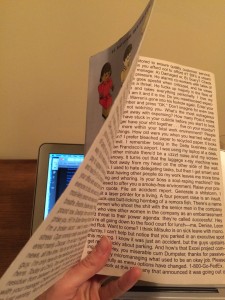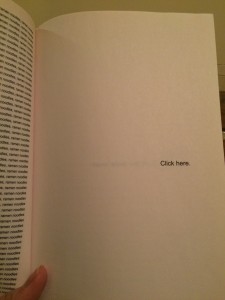One book that has made a lasting impression on me in terms of its materiality has been Douglas Coupland’s JPod. As the story engages with the digital world of video game programmers, so does the format, pushing the boundaries between print and the digital.
There are a number of unusual characteristics that are in conversation with the digital text. There are continuous streaming sentences right on the insides of the book covers and first pages (which are usually left blank) in a Helvetica-esque modern looking sans serif font (Figure 1.).
 Figure 1.
Figure 1.
There are also just pages that list numbers and computer code. At one point in the book a character locates a website that generates the first hundred thousand digits of pi and Coupland subsequently lists them page after page. The book even sets up the reader to engage with the story as if it were setting up a video game, giving the reader the option to “Play as Gene Simmons” or “Play as Iron Man” among the prefatory pages. Among these pages, one cleverly fuses print and the digital and simply says: “Click Here” (Figure 2.). This particular example stood out for me because it implies an action on the reader’s behalf, a reference to a totally different type of reading experience that can’t be explored in print, and yet is cheekily employed here.
 Figure 2.
Figure 2.
The sense of self aware hybridity is especially intriguing as it serves to further Emphasize Matthew Kirschenbaum and Sarah Werner’s discussion of how “all books today are ‘born digital’ in the sense that at some point in their composition, editing, layout and printing they become (re)configured as data objects” (41). JPod works in almost the opposite sense, seeking to make the reader self aware of the book as digital in ways it can’t typically be. The aforementioned title page, encourages the reader to think of the narrative of the story in a leaping hyperlink sort of way, jumping to the next page instead of turning it. This serves the purpose of making the reader aware of how they read in different environments. It also serves to further blur the lines between the print and digital dichotomy bringing the migratory nature of text into the spotlight.
Bibliography:
Coupland, Douglas. JPod. Toronto: Vintage Canada, 2007. Print
Kirschenbaum, Matthew and Sarah Werner. “Digital Scholarship and Digital Studies: The State of the Discipline”. Book History, Volume 17, 2014: 406-458. Online Journal.
